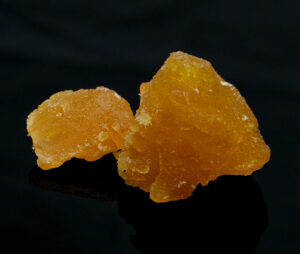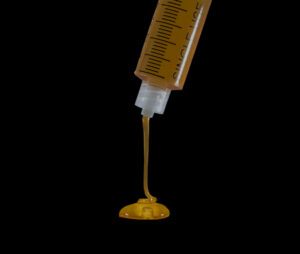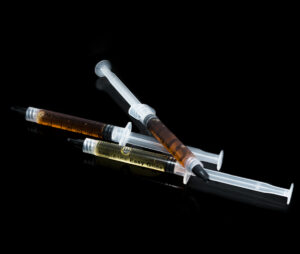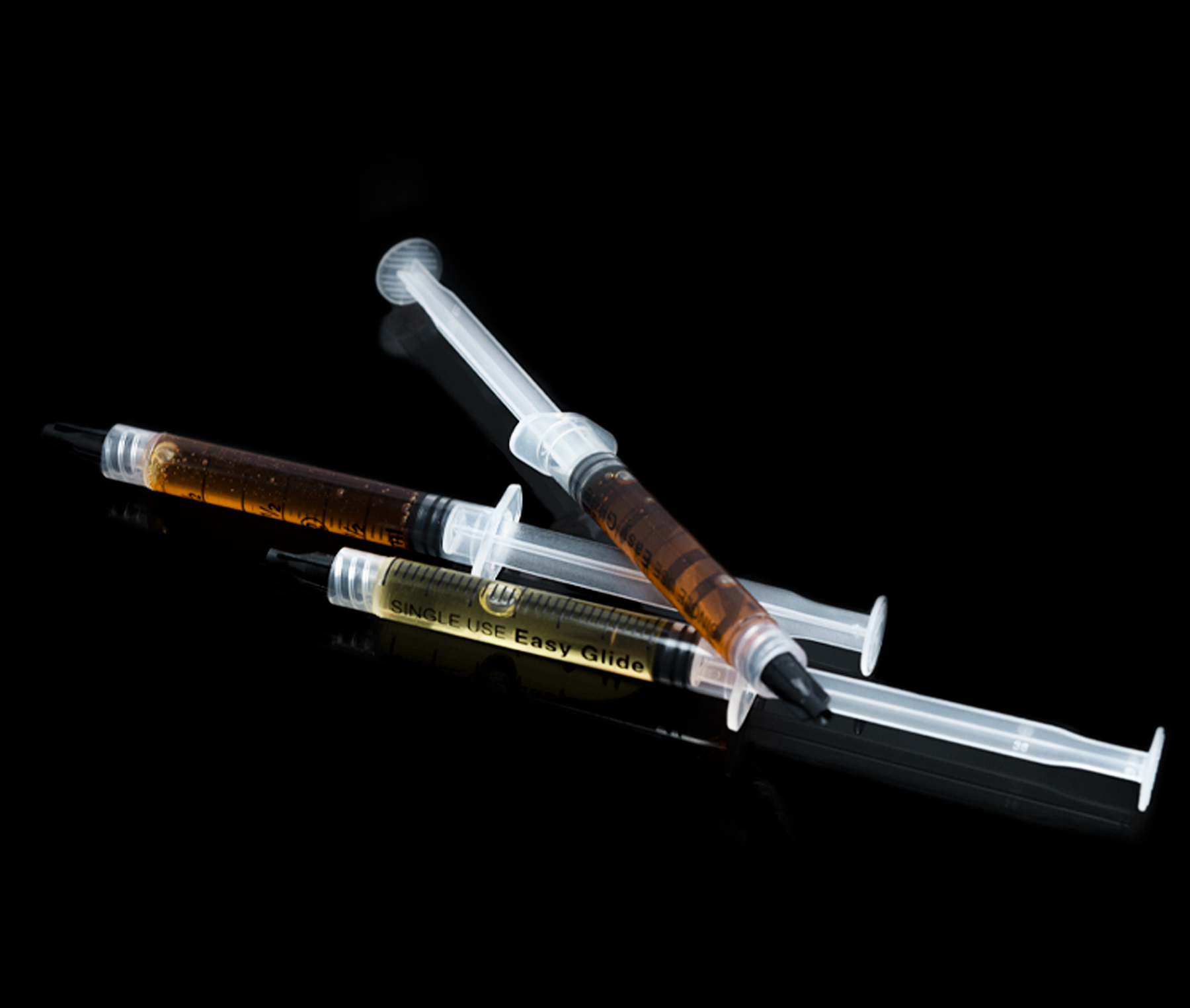With the increasing acceptance of CBD as a viable consumer product, CBD products are appearing in many forms. You can find CBD in lotions for topical applications and in edible products. Of course, you can find hemp flower cultivars, which can be rolled up or placed in pipes to smoke. Also of increasing interest are vaporizers for those uncomfortable inhaling smoke. But when it comes to vaping, distillates top the list as the most popular method. Because distillates have exploded in usage, let’s dive more into what distillate is.
What Is Distillate? The Basics
In its broadest definition, distillate is a concentrate. As the name suggests, concentrates are extracts containing a higher percentage (i.e., concentration) of cannabinoids than naturally occurs in hemp (or cannabis) plants. Concentrates appear in one of two general forms: as solids or oils.
Solid Concentrate Overview

Solid concentrates come in various consistencies. They also retain the original flavors of the plant from which the cannabinoids were extracted. Consuming a smaller amount of concentrates delivers greater effects than larger amounts of a hemp flower bud.
Solid concentrates can be infused into products (i.e., foods and drinks) but the cannabinoids must first be activated via decarboxylation. Another potential disadvantage to infusing with solid concentrates is their unique flavor is combined with foods or drinks. This can alter original flavors beyond recognition.
The most common method of consuming solid concentrates is by applying a high heat to the material. This causes the concentrate to convert to vapors, which are then inhaled. There are many different electric and manual devices available that efficiently vaporize solid concentrates.
Oil Concentrate Overview

In comparison, oil concentrates offer more versatility with distillates standing out as the most popular of all oil concentrates. Other common oil concentrates include FECA, RSO, and C2O Oil. Each is produced by employing different extraction processes.
Distillates are purer than solid concentrates because all plant materials EXCEPT the targeted cannabinoid are removed during the extraction process. This extraction process also eliminates terpenes, compounds that offer unique flavors and effects. The end result is a high concentration of the targeted cannabinoid.
There are two other advantages to distillates: they contain fully activated cannabinoids and they are flavorless. These two facts make the infusion of cannabinoids into other products very easy, as it won’t affect original flavors.
Versatility was mentioned as a feature of distillates. Not only can distillate be added to other products without noticeably affecting the original tastes, natural flavors can also be infused into distillate. This not only offers the consumer different taste sensations when consuming distillate. Flavors can also affect moods and even physical conditions; for instance, the scent of lavender can induce a state of calm for many individuals.
Because of these reasons, flavoring distillates with terpenes is a popular and common infusion option.
Finally, distillates can be vaped or ingested. When compared against other types of concentrates, distillates seem to offer the most positive benefits with few, if any, drawbacks. Distillate proves to be the most popular form of concentrate because of all the factors described above.
The Distillation Process
Distillate is the product remaining after hemp plant materials undergo the distillation process. The distillation process entails converting a substance into a vapor through heat; as it cools, it condenses into an oily liquid state. Because separate components in the hemp plant have different boiling points, cannabinoids can be removed from the rest of the plant at a specific heat level.
At a minimum, the distillation process performs two passes. During the first pass, low boiling point volatiles are removed. The second pass then focuses on distilling the targeted cannabinoid. The second pass removes unwanted contaminants like sugars, waxes, and other leftover plant matter. What remains is crude oil rich with cannabinoids.
Further refining is possible. Each pass produces a distillate with ever higher concentrations of the targeted cannabinoid. In theory, it is possible to end up with a distillate containing 99.9% pure cannabinoids. Any oil measuring 90% or higher in pure cannabinoids is considered a highly refined distillate excellent for directly vaporizing or infusing into other products. Distillates can also be enhanced by adding other compounds. Recently, infusing live resin terpenes into distillates to create custom flavors and effects has gained popularity.
Of all the cannabinoid extraction processes, producing distillate entails the most stringent filtering processes. This results in the purest concentration of cannabinoids.
What Is a Distillate Syringe?

Unless you buy distillate in bulk, your product will be contained inside a plastic syringe. The distillate syringe includes a cap to keep the distillate pure and uncontaminated by external factors.
Because distillate contains a high concentration of cannabinoids, a little drop is usually enough for a session. Therefore, care should be taken when pressing the plunger on the syringe.
Viscosity
Ease of flow depends entirely on the cannabinoid contained in the distillate. For instance, THC-O has a low viscosity. This means that by simply compressing the syringe plunger with your thumb, the distillate will easily flow out of the syringe.
On the other hand, both Delta 8 THC and HHC distillates are highly viscous. This means expressing either Delta 8 THC or HHC distillates requires extra effort. In fact, without lowering the viscosity, it is very difficult to press down the syringe.
Fortunately, there is a simple solution when dealing with thicker viscosities. Applying a mild heat lowers the viscosity enough to allow for a smooth and easy flow. Many consumers simply heat up a teacup of water (30 seconds in the microwave is sufficient) and let their syringe sit in it for 10 or 20 seconds. Others lay their syringe on an electronic device (like a cable box) that naturally emits heat when plugged in.
Of course, once the distillate cools down and returns to room temperature, you will find the distillate to have thickened back to its original viscosity. There is a positive side to high-viscosity distillates, as the distillate won’t seep out of the syringe at normal room temperatures.
Stickiness
Regardless of the viscosity level, most distillates with cannabinoids are sticky. This means if it gets on your fingers or skin, they become tacky. It also causes any surface to turn gummy when in contact with distillate.
Be sure to always have isopropyl alcohol (aka rubbing alcohol) on hand, as it is extremely efficient in removing the stickiness caused by distillates.
What Is a Distillate Cart?

Syringes are great for the adventurous consumer. However, if you are interested in vaping distillates (by far the most popular consumption option), consider using distillate in cartridges (nicknamed “carts,” “vape carts,” or “vapes” by most consumers).
You can screw a distillate cart onto an electric heating device. By pressing a button, the heating element is activated; simply draw on the cart and inhale distillate vapors. It’s clean, discrete, and highly effective. There’s no need to carefully expel a droplet and use another heating device to vaporize it when distillate carts are available!
The bottom line is this: if you plan to vape your chosen distillate, get it in a cartridge!
Consumption Recommendations
By now you are aware that distillates, whether in a syringe or cart, contain high concentrations of the targeted cannabinoid. This means that a little bit can go a long way!
Common unit sizes for syringes and cartridges are 1 ml. This is the equivalent of 1 gram in weight.
These are the potencies for the three distillates we offer:
- Delta 8 Distillate – 96.81% (equal to 968.1mg/g)
- HHC Distillate – 91.28% (equal to 912.8mg/g)
In contrast, a typical CBD hemp cultivar usually contains a potency of between 10% to 20%, or 100mg to 200mg of CBD per gram. Most consumers get noticeable results when consuming ¼ gram or less (50mg or less) of a hemp cultivar in one session. So we emphasize once again that a little bit of distillate (such as a 0.1ml dose) will be stronger that a sizeable hemp bud!
Here is the same potency chart as above, but this time for only a 0.1ml dose:
- Delta 8 Distillate – 0.1ml = 96.81mg/g
- HHC Distillate – 0.1ml = 91.28mg/g
By the way, when you are working with cartridges, we have a similarly simple formula for determining the potency of each puff you take. Here’s how it works: each cartridge contains 1 ml of distillate. A 3-second puff is considered one dose and there are 200 doses in each cartridge.
This chart estimates the potency of a 3-second puff for each cannabinoid:
- Delta 8 Cart – 3-second puff = approx. 5mg
- HHC Cart – 3-second puff = approx. 4.5mg
We always caution customers to start low and go slow. That philosophy applies even more when it comes to our collection of distillates, whether you are using syringes or carts! But as you can see, with carts it’s super-easy to micromanage your consumption levels.
Live Resin vs Distillate
You may encounter a distillate containing live resin. Unfortunately, many consumers are confused by such a declaration. Some people even assume that the distillate produces its own live resins. In actuality, live resins are infused into the distillate to add distinct flavors and effects. Just as distillates are produced from an extraction process, live resins are the result of a different extraction process.
Live resin is a concentrate created by an extraction process using freshly harvested hemp (and cannabis) plants. Rather than performing the traditional harvest process of drying, curing, and trimming the hemp plants, the plants are immediately frozen after cutting. This action preserves the trichomes in the live resin. It also retains the terpenes residing in the trichomes, so the original flavor and aroma is captured at its highest and purest levels.
Even when performed correctly, drying, curing, and trimming are vigorous harvest activities that impact the purity of the original terpenes produced by the plant. While drying and curing effectively eliminates moisture and chlorophyll, it also exposes the trichomes to extra heat, oxygen, and light. Even with the gentlest manual handling, those sensitive trichomes will degrade.
It should be noted that hemp is an incredibly hardy plant capable of producing high volumes of terpenes and cannabinoids. That means a typical harvest still yields high quantities of both those compounds. Now imagine how much more flavor and aroma you can preserve by freezing the harvested plant immediately. This is the main reason Live Resin concentrates remain popular.
Distillate with Live Resins
When you find a distillate boasting live resins, now you know that means the flavors and effects of a particular hemp cultivar were preserved at its most abundant stage (right after cutting the plant). After that process is finished, the end result is infused into the distillate.
A terpene profile refers to the optimal capture and preservation of all the terpenes produced by a given hemp cultivar. When shopping for distillates containing Live Resin terpenes, study the taste and effects of the cultivar from which the live resins were extracted. That way, you are more likely to end up with a distillate offering flavors and results you want! 🙂
How to Make Edibles with Distillate
There are many ways to infuse cannabinoids into foods or drinks. If you want the simplest method, use distillates!
These are the advantages of infusing recipes with distillate syringes:
- Flavorless – because pure distillates are without flavor, it does not affect the taste of the original recipe
- Activated – because the cannabinoids contained in distillates are already activated, there is no advanced preparation required
- Potency Management – because distillates have a high cannabinoid concentration, you can make your recipe quite mild or very strong
- Affordable – once more, thanks to the high potency levels of these distillates, you can add more cannabinoids at less cost than other products
And what might be the disadvantages of infusing recipes with distillate syringes? We’re still trying to figure that out because it seems that distillate syringes are the perfect medium for recipe infusions!
Now You Know Distillates!
Thanks for following this brief tutorial on distillates. You can now consider yourself a distillate expert!

